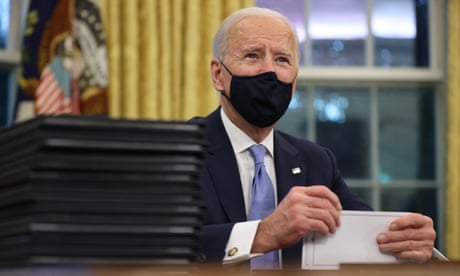When I was writing about minimum wages for the Guardian six years ago, the United States only guaranteed workers US$7.25 an hour as a minimum rate of pay, dropping to a shocking US$2.13 for workers in industries that expect customers to tip (some states have higher minimum wages).
It is now 2021, and yet those federal rates remain exactly the same.
They’ve not moved since 2009. Meaningfully, America’s minimum wages have been in decline since their relative purchasing power peaked in 1968. Meanwhile, America’s cost of living has kept going up; the minimum wage is worth less now than it was half a century ago.
Now, new president Joe Biden’s $1.9tn pandemic relief plan proposes a doubling of the US federal minimum wage to $15 an hour.

It’s a position advocated both by economists who have studied comprehensive, positive effects of minimum wage increases across the world, as well as American unions of the “Fight for 15” campaign who’ve been organising minimum-wage workplaces demanding better for their members.
The logic of these arguments have been accepted across the ideological spectrum of leadership in Biden’s Democratic party. The majority of Biden’s rivals for the Democratic nomination – Bernie Sanders, Elizabeth Warren, Kamala Harris, Pete Buttigieg, Amy Klobuchar, Cory Booker and even billionaire capitalist Mike Bloomberg – are all on record supporting it and in very influential positions to advance it now.
In a 14 January speech, Biden made a simple and powerful case. “No one working 40 hours a week should live below the poverty line,” he said. “If you work for less than $15 an hour and work 40 hours a week, you’re living in poverty.”
And yet the forces opposed to minimum wage increases retain the intensity that first fought attempts at its introduction, as far back as the 1890s. America did not adopt the policy until 1938 – 31 years after Australia’s Harvester Decision legislated an explicit right for a family of four “to live in frugal comfort” within our wage standards.
As an Australian, it’s easy to feel smug about our framework. The concept is so ingrained within our basic industrial contract we consume it almost mindlessly, in the manner our cousins might gobble a hotdog in the stands of a Sox game.
But in both cases, the appreciation of the taste depends on your level of distraction from the meat. While wage-earning Australians may tut-tut an American framework that presently allows 7 million people to both hold jobs and live in poverty, local agitation persists for the Americanisation of our own established standards.
When I wrote about minimum wages six years ago, it was in the context of Australia’s Liberal government attempting to erode and compromise them. That government is still in power and that activism from the Liberals and their spruikers is still present. The Australian Chamber of Commerce and Industry campaigned against minimum wage increases last year. So did the federal government – using the economic downtown of coronavirus as a foil to repeat American mythologies about higher wages causing unemployment increases.

They don’t. The “supply side” insistence is that labour is a transactable commodity, and therefore subject to a law of demand in which better-paid jobs equate to fewer employment opportunities … but a neoclassical economic model is not real life.
We know this because some American districts have independently increased their minimum wages over the past few years, and data from places like New York and Seattle has reaffirmed what’s been observed in the UK and internationally. There is no discernible impact on employment when minimum wage is increased. An impact on prices is also fleeting.
As Biden presses his case, economists, sociologists and even health researchers have years of additional data to back him in. Repeated studies have found that increasing the minimum wage results in communities having less crime, less poverty, less inequality and more economic growth. One study suggested it helped bring down the suicide rate. Conversely, with greater wage suppression comes more smoking, drinking, eating of fatty foods and poorer health outcomes overall.
Only the threadbare counter-argument remains that improving the income of “burger-flippers” somehow devalues the labour of qualified paramedics, teachers and ironworkers. This is both classist and weak. Removing impediments to collective bargaining and unionisation is actually what enables workers – across all industries – to negotiate an appropriate pay level.
Australians have been living with the comparative benefits of these assumptions for decades, and have been spared the vicissitudes of America’s boom-bust economic cycles in that time.
But after seven years of Liberal government policy actively corroding standards into a historical wage stagnation, if Biden’s proposals pass, the American minimum wage will suddenly leapfrog Australia’s, in both real dollar terms and purchasing power.
It’ll be a sad day of realisation for Australia to see the Americans overtake us, while we try to comprehend just why we decided to get left behind.
But in both cases, the appreciation of the taste depends on your level of distraction from the meat. While wage-earning Australians may tut-tut an American framework that presently allows 7 million people to both hold jobs and live in poverty, local agitation persists for the Americanisation of our own established standards.
When I wrote about minimum wages six years ago, it was in the context of Australia’s Liberal government attempting to erode and compromise them. That government is still in power and that activism from the Liberals and their spruikers is still present. The Australian Chamber of Commerce and Industry campaigned against minimum wage increases last year. So did the federal government – using the economic downtown of coronavirus as a foil to repeat American mythologies about higher wages causing unemployment increases.

They don’t. The “supply side” insistence is that labour is a transactable commodity, and therefore subject to a law of demand in which better-paid jobs equate to fewer employment opportunities … but a neoclassical economic model is not real life.
We know this because some American districts have independently increased their minimum wages over the past few years, and data from places like New York and Seattle has reaffirmed what’s been observed in the UK and internationally. There is no discernible impact on employment when minimum wage is increased. An impact on prices is also fleeting.
As Biden presses his case, economists, sociologists and even health researchers have years of additional data to back him in. Repeated studies have found that increasing the minimum wage results in communities having less crime, less poverty, less inequality and more economic growth. One study suggested it helped bring down the suicide rate. Conversely, with greater wage suppression comes more smoking, drinking, eating of fatty foods and poorer health outcomes overall.
Only the threadbare counter-argument remains that improving the income of “burger-flippers” somehow devalues the labour of qualified paramedics, teachers and ironworkers. This is both classist and weak. Removing impediments to collective bargaining and unionisation is actually what enables workers – across all industries – to negotiate an appropriate pay level.
Australians have been living with the comparative benefits of these assumptions for decades, and have been spared the vicissitudes of America’s boom-bust economic cycles in that time.
But after seven years of Liberal government policy actively corroding standards into a historical wage stagnation, if Biden’s proposals pass, the American minimum wage will suddenly leapfrog Australia’s, in both real dollar terms and purchasing power.
It’ll be a sad day of realisation for Australia to see the Americans overtake us, while we try to comprehend just why we decided to get left behind.
No comments:
Post a Comment